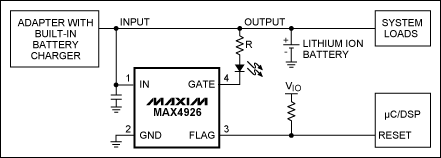

Simple and easy power-OK indic
模拟技术
2510人已加入
描述
Undervoltage/overvoltage (UV/OV) indicators, also called Power-OK (POK) indicators, can notify portable-equipment users when the battery voltage is too low or the battery is being overcharged. POK indicators usually control an external FET to block the supply voltage during such faults. They're also useful as shown, as simple indicators without the FET.
A similar version of this article appeared in the May 1, 2008 issue of PET.
A Power-OK (POK) indicator lights an LED when the power is on and within a specified range. Also known as an undervoltage/overvoltage (UV/OV) indicator, the indicator notifies portable-equipment users when the battery voltage is too low or the battery is being overcharged.
Though it's not difficult to design a circuit for this purpose using a logic gate, two comparators, three bypass capacitors, an LED, and five resistors, the Figure 1 circuit saves board space while lowering cost.

Figure 1. Residing in a 1.0mm x 1.5mm µDFN package, this IC illuminates the LED as long as the power is OK. When an under- or over-voltage condition appears, it turns off the LED and issues a warning to the µC.
Overvoltage protectors of the MAX4923–MAX4926 family usually connect the power source and load through an external p-channel FET, which is normally ON as long as the power is OK. The devices come with factory-preset voltage thresholds as listed in Table 1.
Table 1. UV and OV thresholds for MAX4923–MAX4926 protectors
*Future product—contact factory for availability.
These ICs, however, can also serve as simple power-OK indicators. Use the following equation to calculate R in Figure 1: , where (for example) I ≤ 10mA, the typical RON at 25°C is 160Ω, and VIN is the applied source voltage.
, where (for example) I ≤ 10mA, the typical RON at 25°C is 160Ω, and VIN is the applied source voltage.
打开APP阅读更多精彩内容
A similar version of this article appeared in the May 1, 2008 issue of PET.
A Power-OK (POK) indicator lights an LED when the power is on and within a specified range. Also known as an undervoltage/overvoltage (UV/OV) indicator, the indicator notifies portable-equipment users when the battery voltage is too low or the battery is being overcharged.
Though it's not difficult to design a circuit for this purpose using a logic gate, two comparators, three bypass capacitors, an LED, and five resistors, the Figure 1 circuit saves board space while lowering cost.

Figure 1. Residing in a 1.0mm x 1.5mm µDFN package, this IC illuminates the LED as long as the power is OK. When an under- or over-voltage condition appears, it turns off the LED and issues a warning to the µC.
Overvoltage protectors of the MAX4923–MAX4926 family usually connect the power source and load through an external p-channel FET, which is normally ON as long as the power is OK. The devices come with factory-preset voltage thresholds as listed in Table 1.
Table 1. UV and OV thresholds for MAX4923–MAX4926 protectors
| Device | Package | OV Threshold (V) | UV Threshold (V) |
| MAX4923ELT+* | 6 pin µDFN | 7.18 | 2.44 |
| MAX4924ELT+ | 6 pin µDFN | 6.16 | 2.44 |
| MAX4925ELT+ | 6 pin µDFN | 5.65 | 2.44 |
| MAX4926ELT+ | 6 pin µDFN | 4.46 | 2.44 |
These ICs, however, can also serve as simple power-OK indicators. Use the following equation to calculate R in Figure 1:
 , where (for example) I ≤ 10mA, the typical RON at 25°C is 160Ω, and VIN is the applied source voltage.
, where (for example) I ≤ 10mA, the typical RON at 25°C is 160Ω, and VIN is the applied source voltage.
声明:本文内容及配图由入驻作者撰写或者入驻合作网站授权转载。文章观点仅代表作者本人,不代表电子发烧友网立场。文章及其配图仅供工程师学习之用,如有内容侵权或者其他违规问题,请联系本站处理。
举报投诉
- 相关推荐
- 热点推荐
- SIMPLE
-
CMOS运算放大器OK321S和OK358S与OK321及OK358与OK324的数据手册2021-01-29 1804
-
Make it Easy - Lite Waveform Generator2018-09-30 2530
-
一款很简单的功放,Simple power amplifier2018-09-20 2278
-
“Easy MCU Easy RF”电子技术研讨会2018-06-14 4850
-
SMBus Design Using Low Power Microcontroller2015-03-23 4823
-
Easy!Flow简明安装配置手册2011-04-15 1627
-
Energy Effi cient, Low Power O2010-06-19 558
-
High Power Class D Audio Power2009-11-12 676
-
Optimizing Power Management fo2009-10-01 591
-
隔离式电源电信应用-Isolated Power Suppl2009-04-29 1623
-
KA7526 pdf datasheet (Power Fa2009-02-08 780
-
Simple Power Monitor2009-01-23 1429
全部0条评论

快来发表一下你的评论吧 !

